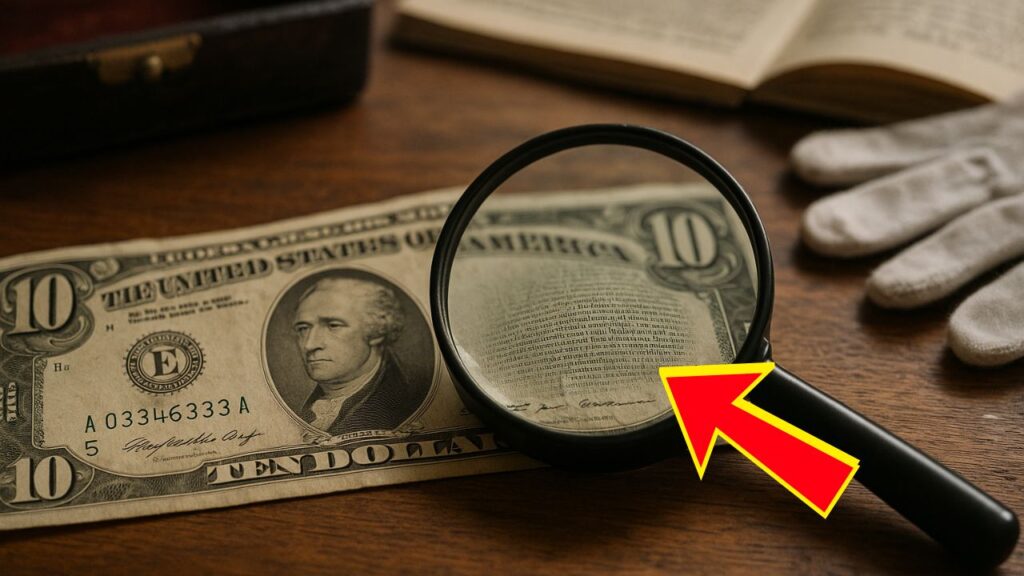In a remarkable discovery at an Illinois estate sale, a 1950-E $10 Federal Reserve Note featuring a microprinting error has emerged, captivating the attention of numismatists and collectors alike.
This rare find underscores the intricate world of currency errors and their significant value in the collector’s market.
Understanding the 1950-E $10 Bill
The 1950-E $10 bill is part of the small-size series introduced in 1928, featuring a portrait of Alexander Hamilton. The “E” designation indicates the series year, and each bill is issued by one of the 12 Federal Reserve Banks, denoted by a letter.
Key Features
- Series Year: 1950-E
- Portrait: Alexander Hamilton
- Denomination: $10
- Federal Reserve Bank Identifier: Letter “E” (Richmond)
- Seal Color: Green
- Security Features: Watermark, security thread, microprinting
The Microprinting Error
Microprinting refers to the use of extremely small text that is difficult to reproduce without specialized equipment. On the 1950-E $10 bill, microprinting is present in various security features, including:
- Security Thread: Embedded with the text “USA TEN.”
- Treasury Seal: Contains microtext readable under magnification.
- Portrait: Hamilton’s portrait includes microtext detailing his name and title.
The error in this particular bill involves misalignment during the printing process, causing the microtext to appear in unintended areas or overlap with other design elements.
Discovery at Illinois Estate Sale
The bill was uncovered during an estate sale in Illinois, where a collection of vintage currency was being liquidated. Upon examination by a local numismatist, the microprinting error was identified, prompting further authentication.
Authentication Process
- Initial Examination: Visual inspection under magnification revealed the misaligned microtext.
- Professional Authentication: The bill was sent to a certified grading service for verification.
- Certification: Upon confirmation, the bill was graded and documented as a genuine error note.
Market Value and Rarity
Currency errors like the 1950-E $10 microprinting error are exceedingly rare, making them highly sought after by collectors. The market value is influenced by factors such as:
- Rarity: Fewer than 10 known examples.
- Condition: Graded as Fine to Very Fine.
- Demand: High interest among collectors of error notes.
Comparable error notes have fetched prices ranging from $500 to $2,000, depending on their specific characteristics and condition.
Collecting and Investing in Error Notes
For those interested in collecting or investing in error notes, consider the following:
- Research: Familiarize yourself with common and rare errors.
- Authentication: Ensure notes are authenticated by reputable grading services.
- Storage: Use acid-free holders to preserve the condition of the notes.
- Networking: Join numismatic societies and attend conventions to connect with other collectors.
Key Details of the 1950-E $10 Microprinting Error Bill
| Feature | Description |
|---|---|
| Series Year | 1950-E |
| Federal Reserve Bank | Richmond (E) |
| Denomination | $10 |
| Microprinting Error | Misalignment of microtext |
| Authentication Status | Certified by professional grading service |
| Estimated Value | $500 – $2,000 |
| Condition | Fine to Very Fine |
| Discovery Location | Illinois Estate Sale |
The discovery of the 1950-E $10 bill with a microprinting error at an Illinois estate sale highlights the fascinating world of currency errors and their significance in numismatic circles.
As collectors continue to seek out rare and unique pieces, this find serves as a testament to the enduring appeal and value of error notes in the world of numismatics.
FAQs
What is microprinting on currency?
Microprinting involves the use of extremely small text incorporated into the design of currency notes, serving as a security feature to deter counterfeiting.
How can I identify a microprinting error?
Microprinting errors can be identified by examining the bill under magnification to detect misaligned or overlapping microtext. Professional authentication services can provide confirmation.
Are error notes a good investment?
Yes, error notes can be valuable investments due to their rarity and demand among collectors. However, it’s essential to authenticate and properly preserve these notes to maintain their value.
